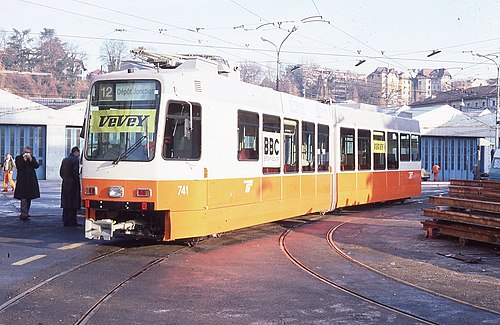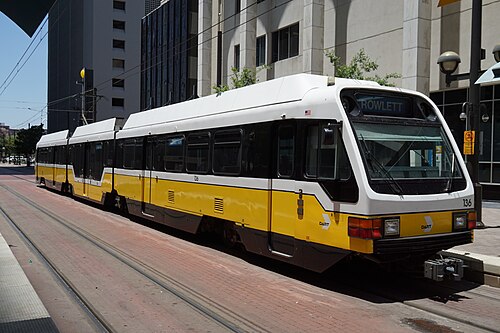With hundreds of high floor trams still in service in Melbourne, and the oldest low-floor trams having entered service in 2002, the State Government is at risk of failing to meet the 2032 deadline for meeting the Disability Standards for Accessible Public Transport. However it didn’t have to be this way – there were many opportunities for Melbourne to introduce low-floor trams in the past, but they were rejected.
The first proposals
The year is 1982 and Victorian Minister for Transport Steve Crabb is presented with a diagram of an articulated two-unit tram with drop centre floors by Sydney-based engineer Dr John Gerofi of Enersol Consulting Engineers.
When asked to provide further information about the concept, Gerofi sought technical assistance from Australian engineering firm Comeng, where coincidentally rollingstock designer John Dunn was also working on a number of low-floor concepts. The pair soon met in person, which resulted in John Dunn drawing up a proposal for a two-unit vehicle with a floor height of 300mm – a floor height unheard of at the time.
The design was presented to the Victorian Government in May 1982 and was well received, but the Chairman of the M&MTB, Dudley Snell, was sceptical – responding “if this idea is supposed to be so good, then why hasn’t anyone else thought of it”.
Comeng and Gerofi were given the go ahead by Crabb to produce a concept design for a low-floor vehicle, but because of the M&MTB the idea was not pursued further.
Instead two prototype B1 class high-floor light rail vehicles were ordered from Comeng, entering service in 1984-85, followed by an order for 130 B2 class trams which were delivered between 1987 and 1994.
Politicians calling the shots
In 1988 the construction of the B2 class tram order well underway, and Minister for Transport Jim Kennan was talking up low-floor trams when asked about the International Light Rail Transport Conference being held in Melbourne that year.
The Met is recognised as a leader in the provision of light rail services. A number of topics are being canvassed at the conference that is being held at the Exhibition Building. The topics include new technologies in the provision of light rail services and the development of a low-floor light rail vehicle-a vehicle which has been developed experimentally in several European countries and which the Met hopes to emulate in Victoria.
Then in May 1989 the minister dropped a bombshell on Comeng – he’d just returned from a visit to Geneva, seen their brand new low-floor trams, and wanted to introduce similar vehicles to Melbourne. The minister had also decided not to call tenders but wanted to renegotiate the existing B2 class tram contract to feature low-floor trams.
Designer John Dunn was again engaged to do the design work spending 1989 coming up with the following design.

Artwork by Phil Belbin for John Dunn/ABB
Meanwhile the Public Transport Corporation, operator of the Melbourne tramways, had not been informed of these plans, and rejected the idea of a low-floor tram outright in November 1989. They were eventually convinced to allow the design work to continue, including the construction of a full-scale mockup.
Progress was slow, and in March 1990 Comeng was ready to make a commitment to the Minister for Transport that they would deliver the first tram in December 1990 if the PTC ceased delaying the project.
However it was not to be – in April 1990 a portfolio reshuffle saw Peter Spyker installed as the new Minister for Transport, and work on the project was paused pending a decision on whether to continue. A few weeks later it was decided to revert to the original contract and complete the remaining B2 class trams to the high-floor design, Comeng being compensated for the work done on the low-floor design, and the incomplete body shell and jigs were scrapped.
The total bill for this lost opportunity – $5.3 million.
Why not retrofit a high-floor tram?
With 130 near-new high-floor trams running around Melbourne and a need for a more accessible vehicle, in 1998 the Public Transport Corporation looked at a different solution – retrofitting a low-floor section in the middle of an existing tram!
Adtranz, the successor of Comeng, was approached to investigate the idea, and again John Dunn was engaged to do the design work. A 6.5 metres long module was decided upon, weight needing to be kept to a minimum to prevent overloading the existing traction motors. Inside there was space for ten fixed seats and six fold-up seats or two wheelchairs, with a floor height of 360 mm with an entrance step 310 mm above rail.
However this proposal was again rejected – the PTC reassessed the proposal and considered that the converted trams would not be powerful enough to operate on steep grades, that the $700,000 cost per vehicle compared poorly to the $2 million a new low-floor vehicle cost, and the infrastructure at tram stops for the modified vehicles would likely be incompatible with that required to support purpose built low-floor vehicles.
So what did we eventually get?
It took until 2001 for Melbourne to finally see a low-floor tram – 36 Alstom Citadis trams designated as the C class.
Followed in 2002 by 59 Siemens Combino trams designated as the D1 and D2 class.
We then had to wait until 2013 for the next low-floor trams to arrive – 100 Bombardier Flexity trams, designated the E class.
And a borrowed idea
In 2019 the Rail Futures Institute released their ‘Melbourne Rail Plan‘, and included a familiar idea.
Given the cost of new trams, a cost-effective alternative may be to insert a centre DDA compliant low-floor module to increase their capacity over a 3 to 4-year program at an estimated cost of $250 million. Cost savings may be possible by recycling some key components from withdrawn Z and A class trams.
In the short term, this would increase the proportion of DDA compliant trams in the present overall fleet from 35% to 61%. With associated life extension works (being undertaken in any event), this would enable these 25-year old vehicles to continue in operation until the late 2030s. It would also defer the requirement for approximately 120 new G class trams by around 10 years with a net cost saving of approximately $400 million during the period to 2034.
Looking overseas – the first low-floor tram
Geneva, Switzerland was the first city with low-floor trams, when prototype Be 4/6 tram no. 741 entered service in 1984.
It was followed by 46 production trams in 1987.
And retrofitted low-floor trams
Many cities around the world have retrofitted low-floor segments to their fleets of high-floor trams. Examples include:
Be 4/8 trams in Zürich, built in 1991-1992, low-floor section prototyped in 1999, and rolled out to the entire fleet in 2004-2005.
The Kinki Sharyo SLRV in Dallas, built in 1996, lowfloor section prototyped in 2002, and rolled out to the entire fleet in 2008-2010.
There are plenty more examples around the world, but you get the idea. 😉
Sources
- Comeng: A History of Commonwealth Engineering Volume 4, 1977-1985 (John Dunn)
- Comeng: A History of Commonwealth Engineering Volume 5, 1985-2012 (John Dunn)
- DDA exemption for Public Transport Corporation for Melbourne trams (Australian Human Rights Commission, 1999)
- Making Public Transport More Accessible for People Who Face Mobility Challenges (Victorian Auditor-General, 2009)
- Introducing low-floor trams to Melbourne, The Bellcord (Geoff Brown, 2019)
- Accessibility of Tram Services (Victorian Auditor-General, 2020)













We don’t just need low floor trams, we need other infrastructure such as the stops, some 1200 in just 10 years.
Only 27% of tram stops level access in 2020, and 100% need to be compliant by December 2020. That is 18 months to upgrade up to 1,215 stops – 68 stops per month, when the average delivery trend is only 21 stops per year, and dropping!
https://www.audit.vic.gov.au/report/accessibility-tram-services?section=
There’s also the idea of rather than modifying trams (or building new trams), but replacing the stops and platforms instead. There’s a lot of advantages that high-floor would bring, including ironically 100% accessibility if done correctly.
In Melbourne’s context, it could be achieved if done on a corridor approach (and clearly one size won’t fit all), forcing aspects of the tram network into LRT rather than streetcars.
How could a “corridor approach” be feasible without splitting the network into incompatible sections? High-floor trams won’t be accessible on low-floor stops, and low-floor trams won’t be compatible at all with high floor stops. Since B-class trams won’t suffice on the St Kilda corridor we’d either have to couple them or build new high-floor trams. In either case we’d still have to continue building new low-floor trams and low-floor stops for the vast majority of the network.
The Pittsburgh Light Rail system mixes high platform and street level stops, so each tram has two sets of doors!
https://en.wikipedia.org/wiki/File:Siemens_SD-400s_4236.jpg
https://en.wikipedia.org/wiki/File:August_2009_Pittsburgh_LRT_Interior.jpg
They could have ordered more Variotrams when Sydney’s production was in full swing. With their 7 units ordered, it must have cost them a fortune. With a Melbourne extension the order will easily be increased to 50 or 100 units which will lower the average cost significantly, benefiting both operators.
The Sydney Variotrams were an odd beast – based on the units running in Chemnitz, Germany.
https://en.wikipedia.org/wiki/Stadler_Variobahn
The plans were sent over to Australia but the local branch of ABB, the successor of Comeng, found the design was unsuited, so had to rework it – a massive amount of work for just 7 trams.
The idea of the low floor section in the B2s was officially part of Yarra Trams’ fleet plan at one point. I’m told they wanted to do it for the St Kilda line, but then when they merged with M>Tram and got hold of the D2s they decided to use those instead.
Way later when Keolis Downer took over the franchise they gave a talk at the Metropolitan Transport Forum and I asked whether the idea was still on the cards – they said no, because the unit cost of converting a B2 was around $2m per tram, compared to a new E class tram at $6m (which they knew would come a long way down as production ramped up). They also said there’s a lot more technical risk involved in modifying a tram than building a new one, and there’s the disadvantage that the old tram has to go out of service before the new one can comes in so it affects fleet availability.
It didn’t stop me wondering what fleet numbers the extended B2s would have been given though… I was thinking of the 3200 series, with the 3 being for three sections and the 2 being a reference to their old number, plus keeping well clear of the C1s and D1s.
If they went ahead with that plan you would have a DDA compliant tram with about 90 seats for 2 million. Sounds reasonable to me.
It would’ve made a lot more sense to do back when they proposed doing it back in 2000 – the B2 class trams were only middle aged, with 20+ years of life left in them.
https://www.theage.com.au/national/victoria/wheelchair-users-take-legal-action-over-frustrating-pace-of-melbourne-tram-upgrades-20210627-p584n8.html
I hope the government gets comprehensively owned by this lawsuit.
[…] that is a thing of the past, but on the tram network not so much – we have squandered multiple opportunities to acquire low floor trams, with the 2032 deadline for an accessible network unlikely to be […]